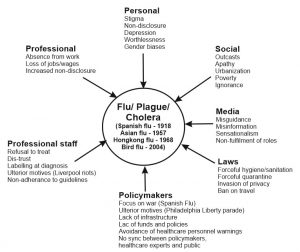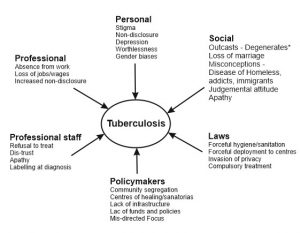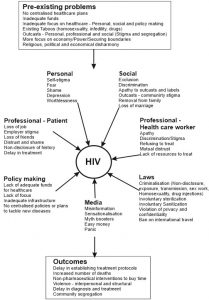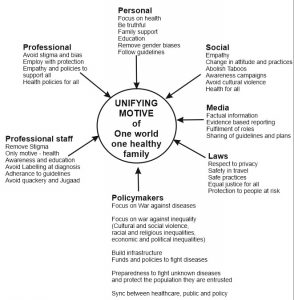Covid Mirror Manuscript
The coronavirus pandemic has taken the entire world for a roller coaster ride. Clearly, the world was not ready to fight it and that is why the non-pharmaceutical interventions (NPI) came into force, “yet again”. It is, as if, we were preparing for a mathematics exam and got a biology paper instead! It is said that history repeats the lessons until we learn. The COVID-19 in the form of a mirror is here to show us our failures as a society; to show us how we have not learnt from the multiple historical attempts made by nature to teach us, resulting in the current inability to fight this minuscule virus.
A battle can only be won if the focus is ‘on the battle’ from all directions. Health needs mental, physical, social and economic well-being and unless all of us declare a war against all factors that affect health in any of the above factors, we cannot win this war. A lot of us are blaming the policymakers, but, this defeat is NOT ONLY their fault. We need to prepare better at individual, interpersonal, social, national and international levels.
Fig 1
Fig 2
Fig 3

The limitations in our response to diseases in past are highlighted in figure 1, 2 and 3. During the flu pandemics, we were busy fighting (World War I and II) and that gave the virus the perfect opportunity to spread to millions. The doctors were deployed in armies, economists were planning for war and the policymakers delayed humanitarian warnings (the Philadelphia liberty loan parade among others). They had very limited healthcare funds, economies collapsed due to war and there was no unifying focus on health. Discrimination among people based on colour (blacks and whites, Asians and whites), religion (Hindus and Muslims, Christians and Jews), economic disparity, gender and other ulterior motives helped the virus spread due to unequal equity distribution.
It is not only viral diseases that have shown us our limitations. Take the plague pandemics or cholera pandemic for example. The 40-day quarantine term was coined during the plague pandemic as the first NPI. It was done to prepare the state medically for it. However, it turned into community segregation and the diseased became untouchable outcasts. The social apathy was appalling, as it is now. The public distrust on doctors, as we see now, is also not new. The Liverpool riots during the cholera pandemic are the best example of how a recipe for disaster can be created by misdeeds of a few. Poverty, urbanization, episodes of Burking along with misinformation made a perfect concoction for riots then and it is the time tested recipe for now too.
Usually, when we see an act of violence, we see only the inciting event. However, there are a lot of suppressed emotions and misconstrued beliefs that finally culminate into an outburst of helpless frustration. The recent racism riots in 2020 are similar events. As in the 1960s, so in 2020. The healthcare disparities, institutional and structural racism, lack of equality and discrimination at all fronts accompanied by social stigma and community segregation, are leading to suppressed anger and helplessness in the subjective minds of many. This leads to the lack of objectivity and an emotional outburst that we all are witnessing now. Anxieties of people unite and culminate into these events. The same applies to doctor-patient conflicts, doctor–management conflicts, and person-person conflicts. Resolving these anxieties is, therefore, an essential goal to achieve health and happiness for all in the world.
Fig 2

Fig 3

As shown in figure 2 and Figure 3, Tuberculosis (TB) and Human immunodeficiency virus (HIV) associated diseases have showcased the worst human behaviour on all fronts. Australia had a law (Section 19 A of the Crimes Act 1958) that criminalized the international transmission of HIV with 25 years of imprisonment which is more than the 20-year punishment for manslaughter. America had immigration laws to prevent the entry of people with HIV which was unanimously accepted by the government. Till nearly 2015, more than 30 countries had this immigration rule. Countries have cases of forceful sterilization and breach of confidentiality from healthcare workers, refusal to treat, discrimination in hospital admissions and what not. The social stigma, loss of marriage and family, sanatoriums as a means of an outcast, loss of wages due to the disease disclosure or due to mandatory treatment regime all led to cases of depression, suicide and community segregation as well as mislabeling of people.
Discussing TB and HIV was shameful in communities, akin to calling Voldemort in Harry Potter. However, these social biases, combined with policy-making biases and media sensationalism produced the worst pandemic that is still ongoing in many developing countries including India. The professional biases also increase the mistrust and harm the fragile bond between the healthcare workers and their patients. Lack of awareness and education, as well as lack of infrastructure and funds, is even now a major factor in controlling these two diseases which made their appearance around 40 years ago.
If we observe the COVID-19 pandemic now, we can see that a lot of above-discussed problems still exist and affect the pandemic response. Funds for healthcare are the lowest in many countries. The national and international wars based on political power, land issues, racial issues, religious issues and many more are still ongoing. Social stigma is there to the extent that families are not allowing their blood to return home after recovery and healthcare workers are being thrown out of their houses and societies. People have turned cases into untouchables and geographical labelling is ongoing. Awareness and understanding of preventive measures are lacking. The role models are themselves wearing their masks off their chin and that is just callousness.
Media sensationalism and misconstrued information, as well as strange mandates such as limiting testing, mislabeling deaths, forging data in journals as well as census, for ulterior motives and namesake, are still happening. Confidentiality has gone out of the roof and mandatory sanitation and community segregation have already happened, as in the past. Shaming on the name of religion, or on the name of economically-deprived people and labelling people as super-spreaders continues to occur. The pandemic of fear, distrust and discrimination that is growing, is more harmful than the disease itself.
We feel that we are technologically and economically stronger, but, in reality, we are morally and ethically much worse. The world is growing closer due to technology, but the hearts are also closing doors fast. We have misused our intelligence for our own individual gains, but, have forgotten the philosophies of Kant, Aristotle, Mill and other great philosophers that, unless we work to improve the happiness of the entire world as a whole, we can never be individually happy. We have created boundaries based on geography, religion, caste, economy, gender, education and all these boundaries are harming us today, not allowing us to unite at the time of need.
The disease’s strongest weapons include not only our poor financial preparation or policymaking but also, our moral, geographical, interpersonal, international and cultural handicaps. The policies are driven by demand in democracy. The policymakers will focus on improving health care only when they see the people focusing on it or asking for it. The repeated lessons in 2020 of a forest fire, cyclones, earthquakes and COVID-19 are proof that the preparation is not enough. We need to be more serious about preserving a symbiotic relationship with nature and put everyone’s health as a priority.
Also, we need to value each and every player in our team to defeat the opposite team. I always use two examples in this regard. One is a game of chess. If you wish to win, you need to protect each and every player of your team, be it the king or the pawn. The same applies to this health care war. Self-centred precautions will not work unless we protect each and every team member as our own. The other is of a football field. If we remove the goalpost from the field, aimless running is not going to help. Similarly, if we keep 8-10 goalposts on the field, we are not going to be coordinated in our efforts to make the goal and win. The unifying goal has to be set to achieve it.
All the stakeholders should focus on doing the work they are trained to do for protecting their people, their world, their economy. Doctors should treat and research with scientists and public servants should work for the public, economists plan for economy and leaders lead with example, if that happens, all diseases will lose the battle. A clear mind with a focused motive to improve the society we live in is what is required. The highest funds, the highest importance and the maximum structural support to healthcare is mandatory at the individual, familial and societal levels. NPI should not be our only defence every time as it affects the economy, the psychology as well as exposes the lack of our preparation.
The Coronavirus is a moral and ethical virus in that regard. It is a strict teacher. It mandates that we learn from our mistakes at any costs, fight the internal wars, harmonize with each other and think only in one direction, one goal – “health for all”, irrespective of caste, religion, race, economy and education (Figure 4). Health is a basic human right and we need to realize its importance. Each and every individual of society is a frontline warrior in this regard. We, doctors, are the last line of defence, as I see it.
Fig 4
 The virus will go one day. We all know that. However, calamities can be opportunities. Let us take this as an opportunity to learn from our mistakes and re-create a history that the coming generations can be proud of. Let us unite for a single cause and be better prepared for similar events in future. As a society, we need to clear the dirt that has accumulated on our soul so that we like our reflection the next time we are shown a mirror of this kind.
The virus will go one day. We all know that. However, calamities can be opportunities. Let us take this as an opportunity to learn from our mistakes and re-create a history that the coming generations can be proud of. Let us unite for a single cause and be better prepared for similar events in future. As a society, we need to clear the dirt that has accumulated on our soul so that we like our reflection the next time we are shown a mirror of this kind.